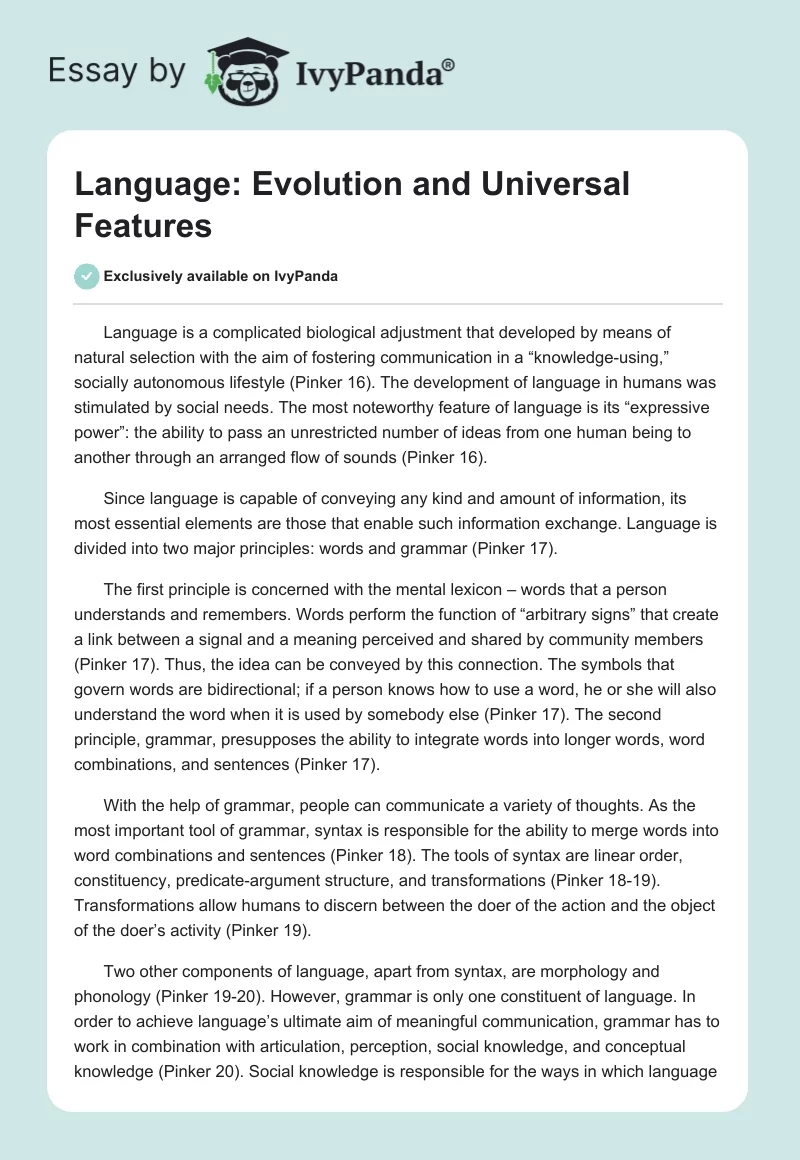Language is a complicated biological adjustment that developed by means of natural selection with the aim of fostering communication in a “knowledge-using,” socially autonomous lifestyle (Pinker 16). The development of language in humans was stimulated by social needs. The most noteworthy feature of language is its “expressive power”: the ability to pass an unrestricted number of ideas from one human being to another through an arranged flow of sounds (Pinker 16).
Since language is capable of conveying any kind and amount of information, its most essential elements are those that enable such information exchange. Language is divided into two major principles: words and grammar (Pinker 17).
The first principle is concerned with the mental lexicon – words that a person understands and remembers. Words perform the function of “arbitrary signs” that create a link between a signal and a meaning perceived and shared by community members (Pinker 17). Thus, the idea can be conveyed by this connection. The symbols that govern words are bidirectional; if a person knows how to use a word, he or she will also understand the word when it is used by somebody else (Pinker 17). The second principle, grammar, presupposes the ability to integrate words into longer words, word combinations, and sentences (Pinker 17).
With the help of grammar, people can communicate a variety of thoughts. As the most important tool of grammar, syntax is responsible for the ability to merge words into word combinations and sentences (Pinker 18). The tools of syntax are linear order, constituency, predicate-argument structure, and transformations (Pinker 18-19). Transformations allow humans to discern between the doer of the action and the object of the doer’s activity (Pinker 19).
Two other components of language, apart from syntax, are morphology and phonology (Pinker 19-20). However, grammar is only one constituent of language. In order to achieve language’s ultimate aim of meaningful communication, grammar has to work in combination with articulation, perception, social knowledge, and conceptual knowledge (Pinker 20). Social knowledge is responsible for the ways in which language is utilized and understood within a social context. Conceptual knowledge supplies words with meaning (Pinker 20). Therefore, language serves not only a linguistic function but also a social one. While some scholars consider language a way of social adaptation, others argue that it is an expression of more comprehensive cognitive abilities—for instance, “general intelligence” or “symbolic capacity” (Pinker 21). The ability to obtain and operate cultural symbols necessitates specific learning mechanisms adjusted to understanding both social and physical environments.
To say that some aspects of language are universal means that some language features are understood by all people, in spite of any differences in origin. The fact that language features are universal is crucial because it enables people to understand each other, even if they do not master many languages. Zeynalov remarks that studying language universals allows scholars to explore the nature of Universal Grammar, whose unique features define all human languages (187).
Language is isomorphic with the genetic code, crystals, and geological processes (Zeynalov 193). The linguistic code appeared naturally in the evolution process in agreement with the structural principles that appeared before it (Zeynalov 193). There are several major universal properties of language. The first one is concerned with the fact that language is common to all social formations and “neurologically normal” people within societies (Pinker 22). While there may exist “technologically primitive” peoples, there are no “primitive” languages (Pinker 22). Even the earliest documented languages were rather complex (Pinker, 22).
In spite of stereotypes about lower classes of society having a non-systematic language, these people’s language actually does conform to strict rules (Pinker 22). The next universal feature pertains to language design, which is similar to all languages (Pinker 22). Languages are not just codes that delineate meaning from sound. Language design peculiarities pertain to every human language (Pinker 22). The third language universal is revealed through ontogenetic advancement (Pinker 22). Regardless of the specific language that a child is learning to speak, he or she must pass through a regular set of phases in order to obtain the necessary knowledge of the language (Pinker 22).
Indeed, children’s speech arrangements, as well as the errors they make, are highly systematic (Pinker 22-23). The next language universal is also connected with the issue of language acquisition. Pinker describes this universal in the following way: if children were to be placed together in an environment without a pre-existing language, they would invent their own (23). Another example is the language of deaf people – they can develop intricate sign languages instinctively and rapidly (Pinker 23). The fifth language universal, as defined by Pinker, is that both general intelligence and language are “doubly dissociable” in genetic and neurological diseases (23). For instance, people with aphasia may have problems with understanding and speaking (Pinker 23).
Language evolution was a crucial step in human development. Due to the universality of language, people are able to communicate within and beyond particular social groups. Language acquisition gives people the opportunity to reach significant goals that would be unattainable without speech and communication.
Works Cited
Pinker, Steven. “Language as an Adaptation to the Cognitive Niche.” Language Evolution, edited by Morten H. Christiansen and Simon Kirby, Oxford University Press, 2004, pp. 16-37.
Zeynalov, Farman. “Universal Properties of Human Language in the Light of Natural Phenomena.” International Journal of English Linguistics, vol. 6, no. 1, 2016, pp. 187-194.


